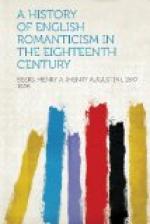The scene of the story was the ancient city of Bristol—old Saxon Bricgestowe, “place of the bridge”—bridge, namely, over the Avon stream, not far above its confluence with the Severn. Here Chatterton was born in 1752, the posthumous son of a dissipated schoolmaster, whose ancestors for a hundred and fifty years had been, in unbroken succession, sextons to the church of St. Mary Redcliffe. Perhaps it may be more than an idle fancy to attribute to heredity the bent which Chatterton’s genius took spontaneously and almost from infancy; to guess that some mysterious ante-natal influence—“striking the electric chain wherewith we are darkly bound”—may have set vibrating links of unconscious association running back through the centuries. Be this as it may, Chatterton was the child of Redcliffe Church. St. Mary stood by his cradle and rocked it; and if he did not inherit with his blood, or draw in with his mother’s milk a veneration for her ancient pile; at least the waters of her baptismal font[2] seemed to have signed him with the token of her service. Just as truly as “The Castle of Otranto” was sprung from Strawberry Hill, the Rowley poems were born of St. Mary’s Church.
Chatterton’s father had not succeeded to the sextonship, but he was a sub-chanter in Bristol Cathedral, and his house and school in Pile Street were only a few yards from Redcliffe Church. In this house Chatterton was born, under the eaves almost of the sanctuary; and when his mother removed soon after to another house, where she maintained herself by keeping a little dame’s school and doing needle work, it was still on Redcliffe Hill and in close neighborhood to St. Mary’s. The church itself—“the pride of Bristowe and the western land”—is described as “one of the finest parish churches in England,"[3] a rich specimen of late Gothic or “decorated” style; its building or restoration dating from the middle of the fifteenth century. Chatterton’s uncle by marriage, Richard Phillips, had become sexton in 1748, and the boy had the run of the aisles and transepts. The stone effigies of knights, priests, magistrates, and other ancient civic worthies stirred into life under his intense and brooding imagination; his mind took color from the red and blue patterns thrown on the pavement by the stained glass of the windows; and he may well have spelled out much of the little Latin that he knew from “the knightly brasses of the tombs” and “cold hic jacets of the dead.”
It is curious how early his education was self-determined to its peculiar ends. A dreamy, silent, solitary child, given to fits of moodiness, he was accounted dull and even stupid. He would not, or could not, learn his letters until, in his seventh year, his eye was caught by the illuminated capitals in an old music folio. From these his mother taught him the alphabet, and a little later he learned to read from a black-letter Bible. “Paint me an angel with wings and a trumpet,” he answered,




